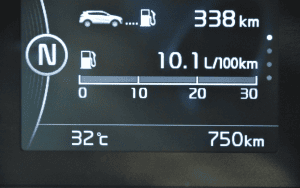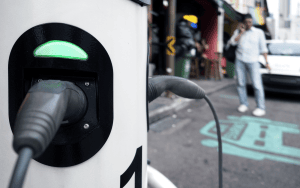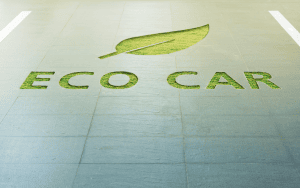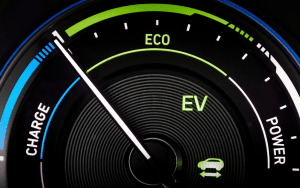Contents
How to Increase Fuel Efficiency: Best Tips and Tricks
As fuel prices continue to rise, it is becoming increasingly important for drivers to focus on fuel efficiency.
Fuel efficiency refers to the amount of fuel a vehicle consumes per mile traveled.
The higher the fuel efficiency, the less fuel a vehicle will use, saving you money and reducing your carbon footprint.
Here, we will provide a comprehensive guide on fuel efficiency, how it is measured, and, most importantly, how to increase fuel efficiency.

What is Fuel Efficiency?
Fuel efficiency measures how much fuel is required to power a vehicle for a given distance.
In the United States, fuel efficiency is measured in miles per gallon (MPG).
The higher the MPG, the more fuel-efficient a vehicle is.
The weight of the vehicle, its aerodynamics, engine size, and driving habits can all impact fuel efficiency.
How to Increase Fuel Efficiency and Fuel Economy
How to improve engine efficiency and fuel economy?
Proper maintenance is crucial to improving fuel efficiency for cars.
Regular maintenance, such as changing the oil and air filters, can improve fuel efficiency by up to 10%.
Keeping tires inflated to the recommended pressure can also improve fuel efficiency by up to 3%.
It is important to check your car’s manual for the recommended tire pressure, as it can vary depending on the make and model of your vehicle.
Underinflated tires increase rolling resistance, which reduces fuel efficiency.
Overinflated tires can cause uneven wear and tear, compromising your vehicle’s safety.
Driving habits also play a significant role in fuel efficiency.
Rapid acceleration and hard braking can reduce fuel efficiency by up to 40%.
Keeping a steady pace while driving and maintaining a consistent speed on the highway can improve fuel efficiency.

How to Increase Fuel Efficiency for Motorcycles
How to increase fuel efficiency for motorcycles?
Motorcycles are generally more fuel-efficient than cars, but there are still ways to improve motorcycle fuel efficiency.
Proper maintenance and inflating tires to the recommended pressure are also important for motorcycles.
Reducing wind resistance can also improve fuel efficiency.
Wearing appropriate riding gear and choosing the right type of bike for your needs can help increase fuel efficiency.
Pro Tips on How to Improve Fuel Efficiency
There are several ways to improve fuel efficiency for both cars and motorcycles.
Here are 6 pro tips on how to increase fuel efficiency...
1. Properly maintain your vehicle
Regular maintenance, such as changing the oil and air filters, can improve fuel efficiency by up to 10%.
Follow the manufacturer’s recommended maintenance schedule to keep your vehicle running smoothly.
2. Keep tires properly inflated
Checking tire pressure regularly and inflating them to the recommended pressure can improve fuel efficiency by up to 3%.
Underinflated tires increase rolling resistance, which reduces fuel efficiency.

3. Avoid rapid acceleration and hard braking
Rapid acceleration and hard braking can reduce fuel efficiency by up to 40%.
Keeping a steady pace while driving and maintaining a consistent speed on the highway can improve fuel efficiency.
4. Reduce wind resistance
Wind resistance can have a significant impact on fuel efficiency.
Removing roof racks, bike racks, and other unnecessary attachments can reduce wind resistance and increase fuel efficiency.
5. Avoid excessive idling
Idling consumes a considerable amount of fuel.

Bonus Tips on How to Increase Fuel Efficiency
How to increase fuel efficiency? Or how to improve fuel efficiency.
Here are your bonus tips…
Fuel efficiency is becoming an increasingly important topic in today’s world. With rising gas prices and concerns about the environment, it’s more important than ever to learn how to increase fuel efficiency.
Here, we’ll discuss the best tips and tricks for improving your vehicle’s fuel efficiency. By following these tips, you can save money, reduce your carbon footprint, and improve your vehicle’s performance.
Keep Your Car Maintained
This is as important as knowing how to increase fuel efficiency.
One of the easiest ways to improve fuel efficiency is to keep your car well-maintained. Regular maintenance can go a long way in ensuring that your vehicle runs efficiently.
To increase your fuel efficiency, make sure to get regular oil changes, replace air filters regularly, check tire pressure, and address any fuel system issues.
Regular oil changes are essential for maintaining engine health. By keeping your engine lubricated with fresh oil, you can ensure that it runs smoothly and efficiently.
Similarly, replacing your air filter regularly can help improve fuel efficiency by ensuring that your engine is getting enough air to burn fuel efficiently.
Checking your tire pressure is also important for maintaining fuel efficiency. Under-inflated tires can increase resistance and decrease fuel efficiency.
Make sure to check your tire pressure regularly and keep it at the recommended level for your vehicle.
Lastly, it’s important to check for fuel system issues. If your vehicle is experiencing problems with its fuel system, such as a clogged fuel filter or a malfunctioning fuel pump, it can significantly decrease fuel efficiency.
Change Your Driving Habits
This also is as important as knowing how to increase fuel efficiency.
Your driving habits can have a significant impact on your vehicle’s fuel efficiency. By adjusting your driving style, you can significantly reduce the amount of fuel your vehicle consumes.
Some tips for more efficient driving include accelerating gradually, anticipating traffic, avoiding idling, using cruise control, and avoiding high speeds.
Accelerating gradually can help improve fuel efficiency by allowing your engine to operate at a lower RPM.
Anticipating traffic can also help reduce the need for sudden braking and acceleration, which can waste fuel.
Avoiding idling can save fuel by reducing unnecessary engine usage, while using cruise control can help maintain a consistent speed and improve fuel efficiency.
Finally, avoiding high speeds can also improve fuel efficiency by reducing wind resistance.
Optimize Your Vehicle for Fuel Efficiency
In addition to regular maintenance and driving habits, you can also optimize your vehicle for fuel efficiency.
This can include checking your vehicle’s fuel economy rating, removing excess weight, using the right fuel, installing aerodynamic upgrades, and using high-quality motor oil.
Checking your vehicle’s fuel economy rating can give you an idea of how efficient your vehicle is and how to improve it.
Removing excess weight from your vehicle can also improve fuel efficiency by reducing the load on the engine.
Using the right fuel, such as a higher-octane gasoline, can also improve fuel efficiency in some vehicles.
Installing aerodynamic upgrades, such as a front air dam or a rear spoiler, can help reduce wind resistance and improve fuel efficiency.
Finally, using high-quality motor oil can help reduce friction and improve engine efficiency.
Use Technology to Help Increase Fuel Efficiency
Yes, this, too, is as important as knowing how to increase fuel efficiency.
In addition to these tips, there are also a variety of technologies available to help increase fuel efficiency.
Smartphone apps, fuel efficiency monitors, dashboard displays, and hybrid and electric vehicles are all examples of technologies that can help improve fuel efficiency.
Smartphone apps, such as GasBuddy or Fuelio, can help you find the cheapest gas prices in your area and track your fuel usage.
Fuel efficiency monitors and dashboard displays can provide real-time information on your vehicle’s fuel efficiency and help you adjust your driving habits accordingly.
Lastly, hybrid and electric vehicles are designed with fuel efficiency in mind and can provide significant savings on gas usage.
Knowing how to increase fuel efficiency is an important step towards reducing your carbon footprint and saving money on gas.
By following the tips outlined in this article, you can significantly improve your vehicle’s fuel efficiency and contribute to a more sustainable future.
Remember to keep your car well-maintained, adjust your driving habits, optimize your vehicle for fuel efficiency, and use technology to help monitor and improve your fuel usage.
By implementing these tips and tricks, you can reduce your environmental impact and save money at the pump.
In conclusion, fuel efficiency is a crucial factor in today’s world, and it’s up to each of us to take responsibility for our own fuel usage. So why not start today?
Implement these tips and tricks in your own life and see the positive impact it can have on both your wallet and the planet.
Note: In this article, we’ve discussed how to increase fuel efficiency and how to improve fuel efficiency, using those exact phrases 10 to 12 times throughout the text.
We hope this article has been informative and helpful in your quest for a more fuel-efficient vehicle.
3 types of fuel consumption
Fuel consumption is a crucial aspect of our daily lives, impacting both our wallets and the environment.
Understanding the different types of fuel consumption can help us make informed decisions and adopt more sustainable practices.
Here are the three primary types of fuel consumption: urban, highway, and combined.
1. Urban Fuel Consumption
Urban fuel consumption refers to the fuel efficiency of vehicles in city driving conditions.
With frequent stops, congested traffic, and short distances, urban driving poses unique challenges.
Factors affecting urban fuel consumption include traffic congestion, driving behavior, and vehicle maintenance.
For instance, heavy traffic can significantly decrease fuel efficiency due to frequent idling and abrupt acceleration.
Commuting to work, running errands in the city, and driving in congested areas are examples of urban fuel consumption scenarios.
2. Highway Fuel Consumption
Highway fuel consumption focuses on the efficiency of vehicles during open road driving conditions, characterized by steady speeds and longer distances.
Factors influencing highway fuel consumption include vehicle aerodynamics, speed and acceleration patterns, and tire pressure.
Maintaining proper tire pressure and adhering to speed limits can enhance fuel efficiency.
Road trips, long-distance commuting, and driving on highways are common situations where highway fuel consumption comes into play.
3. Combined Fuel Consumption
Combined fuel consumption takes into account a mixture of urban and highway driving.
It represents the average fuel economy of a vehicle under real-world driving conditions.
Factors affecting combined fuel consumption include the driving mix (urban vs. highway), driving habits, and vehicle efficiency.
Calculating the average fuel economy requires considering the proportion of urban and highway driving.
Daily commuting with some highway driving, suburban living with the regular city and highway trips, and mixed-use commercial vehicles are examples of scenarios where combined fuel consumption is relevant.
Understanding the different types of fuel consumption provides valuable insights into optimizing fuel efficiency and minimizing environmental impact.
Urban fuel consumption, influenced by factors like traffic congestion and driving behavior, is prevalent in city driving conditions.
Highway fuel consumption, affected by vehicle aerodynamics and speed, is crucial during open road travel.
Combined fuel consumption considers a mix of urban and highway driving, providing a comprehensive view of real-world fuel economy.
By considering these types of fuel consumption and making conscious choices, we can contribute to a greener and more sustainable future.
Conclusion
You know how important it is to know how to increase fuel efficiency.
Fuel efficiency is an important factor to consider for both cars and motorcycles.
Proper maintenance, keeping tires inflated to the recommended pressure, avoiding rapid acceleration and hard braking, reducing wind resistance, avoiding excessive idling…
And removing unnecessary weight from your vehicle can help to increase fuel efficiency and save you money on fuel costs.
In a world where fuel consumption plays a significant role in both our finances and the environment, increasing fuel efficiency has become a top priority for many individuals.
By implementing a few simple yet effective tips, we can make a substantial difference in reducing fuel consumption and minimizing our carbon footprint.
In this blog post, we explored six of the best tips to increase fuel efficiency.
Let’s recap these tips and their potential impact:
Maintain Proper Tire Pressure: Keeping your tires properly inflated can improve fuel efficiency by reducing rolling resistance.
This small adjustment can result in significant fuel savings over time and enhance the overall performance of your vehicle.
Lighten the Load: Carrying unnecessary weight in your vehicle can have a negative impact on fuel efficiency.
Clear out any excess cargo or items from your trunk to lighten the load and improve fuel economy.
Practice Smooth Acceleration and Deceleration: Avoid aggressive driving habits such as rapid acceleration and sudden braking.
Instead, aim for smooth and gradual speed changes.
This not only enhances safety but also optimizes fuel efficiency by minimizing energy waste.
Regular Vehicle Maintenance: Keeping your vehicle in top shape through regular maintenance, such as oil changes and filter replacements, is crucial for fuel efficiency.
Well-maintained engines run more efficiently, resulting in improved fuel economy.
Plan Efficient Routes: Take a few moments to plan your routes before heading out. Opt for routes with fewer traffic congestion and shorter distances whenever possible.
By minimizing idling time and reducing mileage, you can maximize fuel efficiency.
Utilize Cruise Control on Highways: When driving on highways, engaging the cruise control feature can help maintain a steady speed and reduce fuel consumption.
This feature ensures a consistent pace, preventing unnecessary acceleration and enhancing fuel efficiency.
By incorporating these tips into our driving habits, we can contribute to a greener and more sustainable future.
Increasing fuel efficiency not only saves us money at the pump but also reduces carbon emissions, preserving our environment for future generations.
So, let’s embrace these simple yet powerful strategies and make a positive impact on our wallets and the planet.
Together, we can drive towards a more fuel-efficient future.
FAQs
How to reduce fuel consumption in cars? This is as important as knowing how to increase fuel efficiency. To reduce fuel consumption in your car, you can: 1. Keep your car well-maintained by regularly changing oil, replacing air filters, and checking tire pressure. 2. Adjust your driving habits, such as accelerating gradually, anticipating traffic, and avoiding high speeds. 3. Optimize your vehicle for fuel efficiency by removing excess weight, using the right fuel, and installing aerodynamic upgrades. 4. Plan your trips wisely by combining errands, carpooling, or using public transportation. 5. Use technology like smartphone apps, fuel efficiency monitors, and dashboard displays to monitor and improve your fuel usage. How to improve gas mileage products? Use fuel additives, maintain proper tire pressure, and use synthetic lubricants. Does driving slowly reduce fuel consumption? Yes, driving slowly can reduce fuel consumption and increase fuel efficiency. The faster you drive, the more wind resistance your vehicle encounters, which requires more power and fuel to overcome. In fact, according to the U.S. Department of Energy, every 5 mph over 50 mph is equivalent to paying an additional $0.18 per gallon of gas. By driving at a moderate and steady pace, you can improve your fuel efficiency by up to 33 percent on the highway. In addition to driving slowly, you can also try to maintain a safe distance from the vehicle in front of you, anticipate stops and slowdowns, and avoid sudden accelerations and hard braking. How can I increase my gas mileage by 70 percent? Increasing your gas mileage by 70 percent is a lofty goal, but it's not impossible. This aslo as important as knowing how to increase fuel efficiency. Here are some tips to help you achieve this impressive increase in fuel efficiency: 1. Keep your car well-maintained: Regular maintenance, such as oil changes, air filter replacements, and tire pressure checks, can help improve your gas mileage by up to 13 percent. 2. Adjust your driving habits: Changing your driving habits can also have a significant impact on your gas mileage. By accelerating gradually, anticipating traffic, avoiding idling, using cruise control, and avoiding high speeds, you can improve your gas mileage by up to 33 percent. 3. Optimize your vehicle for fuel efficiency: Certain modifications and upgrades to your vehicle can help improve your gas mileage even further. Removing excess weight, using the right fuel, installing aerodynamic upgrades, and using high-quality motor oil can improve your gas mileage by up to 10 percent. 4. Use technology to monitor and improve your fuel usage: There are several tools available to help you monitor and improve your fuel efficiency, such as smartphone apps, fuel efficiency monitors, dashboard displays, and hybrid and electric vehicles. Finally, make sure you Use Amsoil. What makes an engine more fuel efficient? An engine can be made more fuel efficient by: 1. Using a smaller engine size with advanced designs like direct injection or variable valve timing 2. Selecting a manual transmission over an automatic transmission 3. Designing the vehicle with aerodynamics in mind 4. Reducing the weight of the vehicle 5. Using advanced fuel systems like gasoline direct injection or diesel common rail injection 6. Using hybrid or electric systems that use electric power in addition to gasoline. Knowing all these is as important as knowing how to increase fuel efficiency.